Chicago Outfit boss Sam Giancana aided a CIA plot to kill Fidel Castro, allegedly helped assassinate President Kennedy, and may have been with Marilyn Monroe on her last night alive.
Powerful mobsters proliferated in 20th century America, but their influence didn’t remain in the underground world. There were mafiosos believed to have affiliations with the highest rungs of the U.S. government, from Santo Trafficante Jr., who was potentially part of a plot to poison Fidel Castro with a milkshake, to Lucky Luciano, who aided the U.S. in World War II using his connections with organized labor on city waterfronts.
But perhaps few criminal figures present as intriguing a conspiratorial connection to the government than Sam Giancana. The Chicago boss went from underling to racketeering royal and finally, CIA cohort, which eventually brought on his own ignominious ending. Maybe more tantalizing still is that his name is inextricably tied to the demise of John F. Kennedy Jr.
It’s well-known that the mob probably helped to elect JFK, but not everyone knows that America’s favorite playboy was actually pals with Giancana. Kennedy and the mobster likely shared the same women, including Judith Exner, Phyllis McGuire, and even Marilyn Monroe. So how did this friendship end with both men’s bloody murder?
Sam Giancana’s Unhappy Home Life
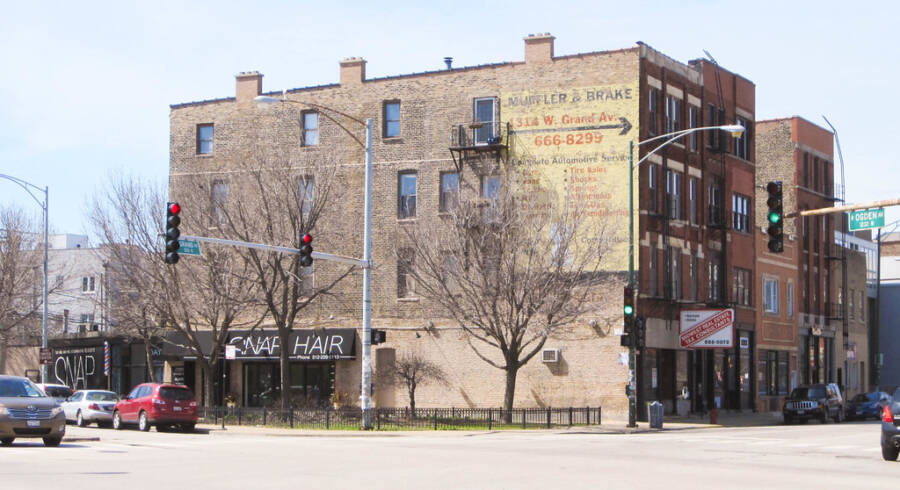
Stephen Hogan/FlickrThe former site of one of Sam Giancana’s Chicago hangouts, Patsy’s Restaurant.
Salvatore Giancana was born Gilormo Giancana on June 15, 1908, in Chicago, Illinois. The son of Sicilian immigrants was baptized Momo Salvatore Giancana and grew up in a brutal household in Chicago’s Little Italy neighborhood, called The Patch.
According to a biography of Giancana titled Double Cross — penned by his younger stepbrother, Charles, and his godson — Giancana was unruly from the beginning. His father, Antonio, would chain six-year-old Giancana to an oak tree in their backyard when he disobeyed. Then, he would proceed to beat him with a razor strap.
When “Sam,” as he was nicknamed, finally begged for mercy, Antonio would leave him alone for a few hours. Eventually, Antonio would unchain him and “allow” the boy to sleep the night in the family kitchen. His mother wasn’t there to protect him, as she died when he was just a toddler. Perhaps it’s no wonder then that Sam Giancana grew up full of rage.
Giancana remained a disobedient pupil in school and was consequently sent to a reformatory school by the age of ten. His father soon remarried and populated the home with half-siblings — besides his full sister, Lena, whom Giancana admired. Quickly, there didn’t seem to be much room for him at home. As a result, the truant fell in with rough crowds, namely the so-called “42 Gang.”
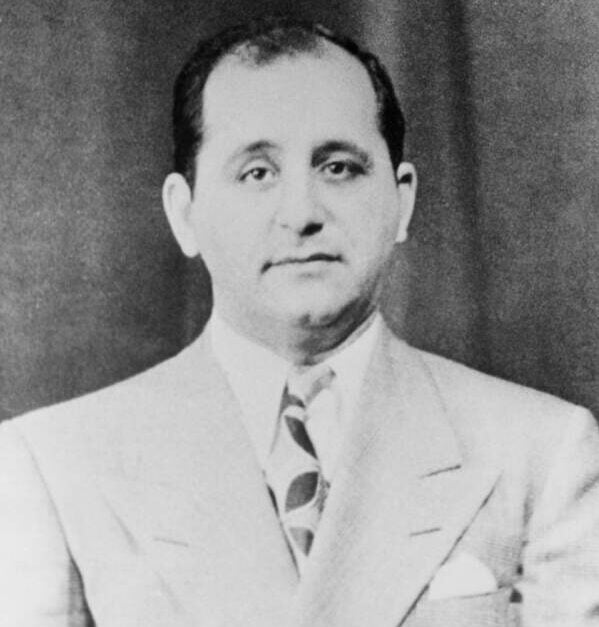
Getty ImagesA younger Sam “Momo” Giancana when he was the number two leader of the Chicago crime syndicate.
The 42 Gang, made up of mostly Italian boys and teens, dominated the West Side of the Windy City in the 1920s and 1930s. The gang robbed wealthy women, committed murders, stole cars for parts, and bootlegged liquor during Prohibition. Giancana was arrested the first time at 17 for auto theft, and by age 20, Giancana had racked up several stints in jail and was suspected of having had a hand in three murders (though for these he was never tried).
Sam Giancana quickly rose to a position of power in the 42 Gang.
As fellow gangster Tony Montana told the Los Angeles Times in 2014:
“He was into some things with a bunch of guys, including Milwaukee Phil and the English brothers, and they were robbing and shaking down so many joints that Capone took notice of them.”
With this introduction to Al Capone, Sam Giancana’s criminal career reached new heights.
Sam Giancana’s Meteoric Rise To Power In Chicago

Wikimedia CommonsAl Capone’s mugshot from the 1930s.
Giancana soon left the 42 Gang behind to become a driver for Capone’s alcohol smuggling operation.
He served as a getaway driver for Capone and his associates “Machine Gun” McGurn and Tony “Big Tuna” Accardo. According to a 1975 obituary for Giancana in New York Magazine, those two mobsters likely played major roles in Capone’s infamous St. Valentine’s Day Massacre.
Giancana escaped the World War II draft when a Selective Service psychologist deemed him a “constitutional psychopath.” Giancana joined the war effort in his own way by manufacturing fake ration stamps and selling them for exorbitant prices.
Also in the early 1940s, Giancana found himself in prison yet again. While locked up, he met a man revered by fellow inmates: an African-American named Eddie Jones. Giancana befriended Jones, who told him all about the illegal gambling rackets he ran in the African-American community. They were called “policy rackets” and were lotteries for Chicago’s lower classes, described in a 2013 Chicago Tribune article as “the Monte Carlo of the working class, the Las Vegas of the down and out.”
Naturally, Sam Giancana wanted in and so, upon his 1942 release, he enlisted Accardo in helping him to take the rackets over that raked in tens of millions of dollars annually. In doing so, Giancana terrorized the black community on Chicago’s South Side.
He started out by abducting his former pal Eddie Jones in 1946. Giancana seized Jones in plain daylight — in fact, in front of his wife and secretary — and shoved him into a van. The cops chased Giancana, whose cohorts fired and even wounded an officer.

Francis Miller/The LIFE Picture Collection via Getty ImagesAnthony Accardo during a trial for tax evasion.
In exchange for a $100,000 ransom, Jones and his brother agreed to leave the policy racket to their partner, Teddy Roe, and Giancana. Later that same year, an attempt to kidnap Roe failed, but Roe refused to back down to the Italian organized crime outfit. In 1952, Giancana and his thugs murdered Roe, the last major opposition to running Chicago’s policy rackets.
By the middle of the decade, Giancana had become the head of the Chicago outfit, especially since Al Capone had died five years earlier and his close associate Accardo stepped down. He was now at the top of his game.
An Unlikely Friendship
Though he had married and fathered three girls, Sam Giancana would become to be known as a womanizer. His wife died in 1954, leaving him to care for their children on his own. The mobster would never remarry, but he did take many a lover.
Through his friendship with none other than Frank Sinatra and his extramarital mistress Judith Exner, Giancana was introduced to another American playboy: John F. Kennedy Jr.
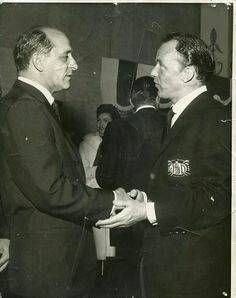
LA TimesFrank Sinatra, on the right, with Sam Giancana.
In fact, stunner Exner was rumored to be JFK’s inbetween with organized crime. In 1988, she recounted a meeting between the two to People — one that she set up. Exner said:
“It was a short meeting early in the evening. Sam arrived first and then Jack, who put his arms around me and said, ‘I’m sorry I can’t stay and see you for the evening.’ He was in town to address a Democratic party dinner. He then went over and shook Sam’s hand. Sam said hello; he called him Jack, not Mr. President. I asked them if they would like me to leave. Jack said, ‘No, I’d rather you didn’t.’ I guess he didn’t want me to be seen leaving the room. To give them privacy, I then went into the bathroom, sat on the edge of the tub and waited until they were finished.”
But Giancana’s meeting with JFK seemed fated anyway. The Chicago Outfit and other organized crime syndicates allegedly worked to get JFK elected in 1960. Additionally, one of Giancana’s long-term girlfriends was singer Phyllis McGuire, who later told national publications all about the intimate relationship between Kennedy and Giancana that developed over the years. As McGuire told the Sun-Sentinel, both men allegedly slept with starlet Marilyn Monroe.
Exner added that after Senate reports emerged in the 1970s, “it finally dawned on me that I was probably helping Jack orchestrate the attempted assassination of Fidel Castro with the help of the Mafia.”
Sam Giancana was also allegedly tied to Marilyn Monroe, with whom she was in love upon her 1962 death. “The night before she died, the last time I saw her, was in Lake Tahoe at the Cal-Neva Lodge. She was there with Sam Giancana, who was the head of the Mafia,” said Monroe’s hair-stylist to his son in a recording upon his death.
The sex symbol was reportedly prepared to reveal her affairs with the Kennedys. “I really think the FBI did it,” her hairstylist continued.
A Web Of Cuba, Castro, And The Kennedys
Sam Giancana’s assassination expertise and connection to the Kennedy family came in handy for the United States government in the 1960s.
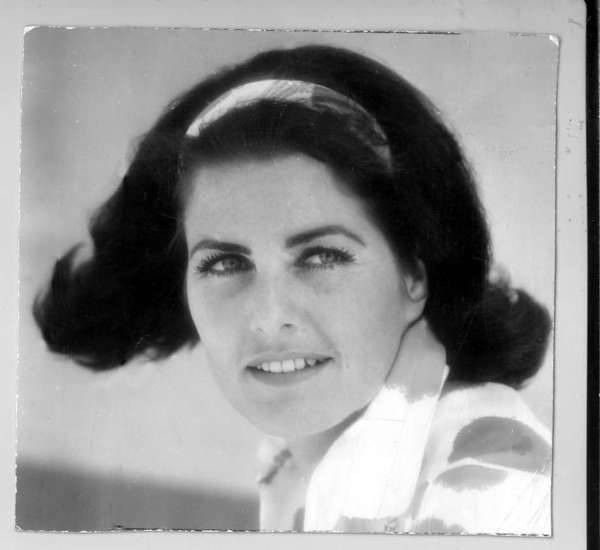
LA TimesThe alleged mistress of both Sam Giancana and John F. Kennedy, Jr., Judith Exner.
At that point, the CIA was trying to take down Cuban dictator Fidel Castro through a medley of covert — albeit bizarre — tactics. To eliminate him, they enlisted their own enemies, namely, the Mafia. Giancana was interested in the mission, considering that with Castro’s ascension also came the demise of Cuban casinos, from which Giancana and other mobsters profited. If Castro was ousted, Giancana could resume the expansion of his criminal empire in the Latin American market.
Recently declassified files from August 1960 to February 1963 reveal that the CIA enlisted private investigator Robert Maheu, a frequent federal collaborator, to reach out to the underworld for assistance. Maheu met smooth-talking mobster Johnny Roselli, who introduced him to his cohort, “Sam Gold.” Eventually, it was revealed “Sam Gold” was Sam Giancana.
Rumor has it that the CIA indirectly offered Giancana hundreds of thousands of dollars in exchange for his “services,” but Giancana refused on the grounds that he just doing his patriotic duty. But Giancana likely hoped that in exchange for killing Castro, the newly-elected President John F. Kennedy would get his brother — the future Attorney General Bobby Kennedy — to lay off the Mob.
Indeed, in 1962, Robert Kennedy had agreed to stop investigating Giancana and his associates temporarily, but was annoyed that the CIA had agreed to deal with the underworld without his approval.
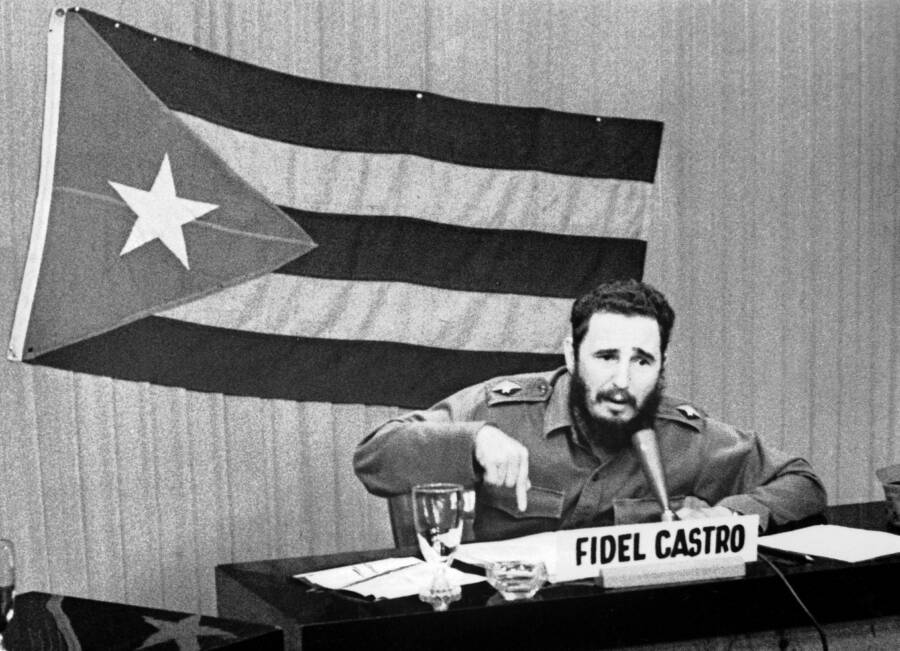
Keystone-France/Gamma-Keystone via Getty ImagesCuban Prime Minister Fidel Castro criticizes the United States on their naval blockade of Cuba in a public speech in Havana. Oct. 22., 1962.
Giancana and Roselli engaged in numerous efforts to off Castro. The more they tried, however, the more spectacularly they failed.
Miami mob boss Santo Trafficante, Jr. offered them a man who could get inside Castro’s kitchens. On their orders, this man poisoned Castro, but the poison didn’t take and the dictator survived. Another effort was to contaminate Castro’s food with poison hidden inside a pencil. This also failed.
Eventually, Giancana grew furious with Robert Kennedy’s attempts to take down the Mafia. Accounts differ, but it’s suggested he and his organized crime brethren were behind John Kennedy’s 1963 assassination in retaliation for RFK’s efforts against the mob.
By this time, Sam Giancana and his family lived lavishly. After he died, Giancana’s daughter, Antoinette “Toni” Giancana, spoke out about the way she grew up, even publishing a memoir. In 1978, she told People that “Dad would always take me around to show me off to his friends when I was a little girl. I always wore a white bonnet, white gloves, little white patent leather shoes. I was always, ‘his little princess.'”

Denise Truscello/WireImageSecond from left is Cynthia Duncan, the grand-daughter of Meyer Lansky, and behind her in orange is Antoinette Giancana, the daughter of Sam Giancana.
But by the mid-1960s, Sam Giancana’s fate would take a distinct downturn.
Sam Giancana Goes From Assassin To Assassinated
In 1965, Sam Giancana was jailed for refusing to testify on organized crime before the Senate. Silence between mafiosos and the outside world is required by all its members under the practice of omerta. But Giancana’s colleagues nonetheless decided to oust him from the outfit in 1967.
Without his power base and worried that the FBI was on his tail for his participation in Castro’s attempted assassination, Giancana fled to Mexico and then to Argentina in a self-imposed exile of sorts.
In 1974, Giancana returned to the U.S. By the following year, word had gotten out publicly that the CIA had used underworld connections to try to kill Castro. The Senate convened official hearings on the subject and called Roselli and Giancana as witnesses.
Giancana would never testify.
On June 19, 1975, Sam Giancana was visited by an unknown party in the basement kitchen of his Oak Park, Illinois, home. While cooking sausage and peppers, Giancana was mortally wounded in the head and neck as the assailant fled.
The identity of the assassin — likely a mob cohort who did not want Giancana to testify before the Senate — remains officially unknown, but theories abound.
Former Chicago mobster Frank Calabrese Jr. told MSN that he knows who did it, but will never spill the beans. Windy City Mafia historian John Binder alleged that Giancana’s chauffeur, Dominic “Butch” Blasi, pulled the trigger. Binder told ABC7 Chicago: “He was there that night. A car registered to him or to his family returned there that evening after everyone else had gone home. Not long thereafter they found Giancana dead on the floor of his basement.”
But both Sam Giancana’s namesake nephew and a Chicago cop claimed that another close pal, Tony “the Ant” Spilotro, did the deed.
Either way, it’s not surprising that the following year, Giancana’s best pal and former partner in crime, Johnny Roselli, was also snuffed out.
The story of one of America’s deadliest gangsters doesn’t end there, though, as the extent to his involvement in the assassination of JFK remains an enduring mystery and fodder for conspiracy theorists to come.
If you enjoyed Sam Giancana’s story, learn about the real-life mobsters who inspired Goodfellas. Then, dive into the scandalous tale of another criminal from days past, Wild West outlaw Big Nose George.






